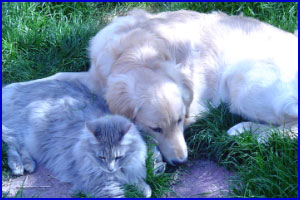
The conflict between cats and dogs is legendary.
Indoors, cats who are raised around dogs develop survival strategies. Outdoors, cats see themselves as predators while dogs see them as prey. Running elicits the prey/chase response, even with some dogs who live peacefully with cats. This means that some dogs who live peacefully with cats will chase another cat, especially if it runs.
Wise cats learn to move slowly when dogs are around. If they are allowed outdoors, they try not to get caught in the open without access to a tree or fence they can scale.
Outside, cats are at the mercy of dogs as well as neighborhood predators, domestic and wild. (and cars!) A cattery, a harness and leash, or a cat fence, (a barrier of netting or wire specifically designed to keep your cats in or stray cats out), will allow your cats to be outside without being injured or killed. Commercially made cat fence products are available. Personally, I prefer to keep my cats safely indoors with a ‘catio’ that allows them to go ‘outside’ yet still confined to the home .
If your resident dogs and cats have already established a peaceful relationship, you probably don’t need to worry. But any time you add a newcomer to the pride or pack, you need safeguards to protect your pets from injury.
Remember, the risk goes both ways. Your dog’s jaws can be lethal to your kitty, and while the kitty likely will not kill your dog, his sharp claws can cause mayhem and easily inflict permanent damage to your dog’s eyes, even if the kitty’s intentions are innocent. If you think there is a chance your cat will seriously attack your dog, take steps to protect him. SoftPaws, which are brightly colored plastic tips glued onto your cat’s claws, can prevent damage to your dog’s eyes while you improve their relationship.
Proper introductions and good behavior management tools can greatly reduce the risk of injury to both of your kids.
The more you know about the animals you are about to introduce the better prepared you will be. When you are walking your dog on lead, does he show an unhealthy interest in neighborhood cats? Does he tolerate cats that jump into your yard or charge after them with aggressive intent? Has your cat been around dogs before? How has she reacted? Does she hiss and spit when she sees dogs walk by the front window?
If you do not have the answers to these questions, take extra precautions. However, remember that even dogs and cats who have lived peacefully with each other in a previous home may take some time and management as they adjust to a new situation.
When you bring a new dog into the house, protect your cat until you are sure the dog “works and plays well with others”. Begin, before you bring the dog home, by creating safe places for the cat to go in areas where the dog will have access. Baby gates and cat doors are a big help as are catwalks and other cat-friendly perches out of dog-reach. Be sure your cat knows how to get to and use them. Put high value treats, (‘Kitty Cavier’ is an excellent choice and available at most pet stores), in the spots where you want your cat to hide. Encourage her to explore the perches you have provided for her by baiting them with treats and catnip.
If you have a kitty door, help the cat learn to go through it by holding the kitty-door open and luring her through with a treat. Gradually lower the flap as you lure the cat through until she starts pushing it open herself.
Help her practice jumping the baby gates by tossing her favorite treats over them and watch her sail over them. If your dog is large, use a baby gate with vertical bars that your cat can get through easily and your dog cannot get through at all.
Spend time teaching the dog to “sit” and “don’t” (Better than “leave it”!) Teach him to “sit” quickly and every time you tell him to sit. Before you bring him into the house for the first time, review “sit” several times. Bring him into the house on a lead. If he is a strong dog and you doubt your ability to restrain him, use a head halter. The Halti is the preferred halter and it should be used with a separate lead from the one on your dog’s neck collar. Both should be used together.
Once your cat is familiar with her escape routes, which could take some time, you are ready to introduce your dog. In the meantime, take a clean towel to the home where the dog is currently living and rub him with the towel. Place that towel under your cat’s dinner bowl so that she becomes familiar with the dog’s scent. Rub the cat with a towel and put it under the dog’s bowl to familiarize him with the cat’s scent.
Before you take your dog into the house rub a towel on the cat then rub the towel over the dog, putting the cat’s scent on the dog. Then rub a towel over the dog and rub it on the cat. Same purpose.
Sit in a room with your dog on lead and invite the cat into the room with a happy voice and tempting treats. She needs to come in under her own power and choice.
DO NOT CARRY HER INTO THE ROOM! If you carry her into the room and she panics she may scratch or bite you badly and you will be behind the training curve. Allow the cat to take her time, even leave the room if she chooses. This should be as stress-free an interaction as possible. Toss some favorite treats near her. This ‘tells’ her that the dog is a good thing. He brings treats!
NOTE: If your cat bites you and breaks the skin, go IMMEDIATELY to the emergency room. A cat bite is far worse than is a dog bite. Cat teeth are long, narrow and very sharp. They puncture very deeply into flesh and introduce into the wound, many bacteria including the extremely pathogenic bacterium Pasteurella multocida. Many of these deep bites require surgical intervention and can result in the loss of the use of the area bitten.,… usually the hands.
Observe your dog. If he remains sitting or lying quietly watching the cat, you are going in the right direction. Be careful. Some dogs ‘trick’ cats into complacency. They will look calm but are preparing to strike. Watch your dog’s eyes, head and other body ‘language’. If his body is tense, massage him, slowly, under his ears and talk with him gently. Do not coddle either animal. If he is calm and relaxed, tell him “good don’t” and “good stay” as you give him treats. As he eats his treats, say the cat’s name and “kitty” or whatever other pet name you have for your cat. Keep the dog on lead and walk the dog around the room slowly and casually. Allow the cat full freedom to stay or run. If the cat runs, watch the dog’s reaction. The cat’s run may key into the dog’s prey drive and cause him to chase the cat. Gently remind the dog to return to the position in which he was told to “stay” and tell him to “stay”. Use NO PUNISHMENT whatsoever. This should be a gentle interaction. Use “watch” and when your dog looks at you, gently yawn at him and flick your tongue a few times. This is a calming technique that ‘tells’ your pup that the situation is ok and he should not worry.
If your dog seems ok with the cat but is interested, have him perform some ‘doggy pushups’, (“Sit”, “Down”, “Stand”, “Down” etc.) and give him treats for paying attention to you rather than the cat.
If your dog is excessively interested in the cat, distract him with “watch”, “touch”, pushups and other tricks that you’ve taught him. Walk him out of the room, have him perform one or two tricks then bring him back into the room and give him many high value treats, one after another. What you are telling him is that the cat brings great treats. Repeat this process until he starts sitting and looking for treats whenever he sees the cat. This may take many repetitions and several days.
Be patient and careful. Not all dogs will make friends with cats but most will.

